
St Alban's Chapel, The Southport School
[Photograph by Geoffrey Cox (September 2014)]

St Alban's Chapel, The Southport School
[Photograph by Geoffrey Cox (September 2014)]
Historical and Technical Documentation by Geoffrey Cox
© OHTA 2012, 2018, 2020 (last updated September 2020)
The Southport school was founded in 1901 by the Rector of St Peter's Church, Southport, The Revd H.H. Dixon (who later became Bishop Coadjutor of Brisbane), and moved to its present site on the banks of the Nerang River in 1902. First known as 'Southport High School', although it operated initially as a Junior School, it was taken over by the Anglican Diocese of Brisbane in 1912, becoming the first Protestant secondary school in Queensland. The original buildings on the site were old government buildings, and the main house by the river had been occupied by the Governor of Queensland as a summer residence.1
The St Alban's Memorial Chapel was designed in Gothic style by the architects H.W. Atkinson and Conrad of Brisbane, and was consecrated by the Archbishop-elect of Brisbane, Dr Sharp, on 13 November 1921. The interior features panelling and stalls of Queensland Oak.2
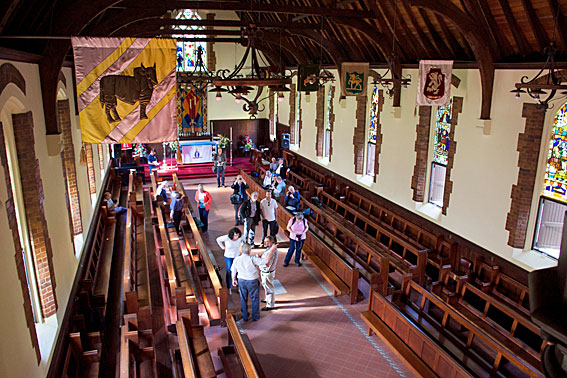
The interior of St Alban's Chapel, The Southport School
[Photograph by Rodney Ford (September 2014)]
First Organ.
The first organ in St Alban's Chapel was installed around 1921 when the chapel was built. It was moved in 1924 to St Peter's Anglican Church, Southport.3
Present Organ.
The present organ was built in 1924-25 by Whitehouse Bros of Brisbane at a cost of £1,569.15.0.4 The order for the instrument had been placed early in 1924, and it was expected initially to be completed by November that year. It was not opened and dedicated, however, until 22 February 1925.5
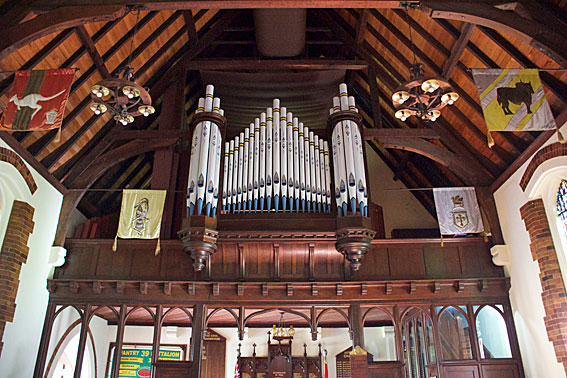
The 1925 Whitehouse Bros organ
in St Alban's Chapel, The Southport School
[Photograph by Rodney Ford (September 2014)]
A newspaper report at the time of the opening reveals that the casework of the organ was designed by the diocesan architects, Messrs. H.W. Atkinson and A.H. Conrad, who had designed the chapel itself. The same report gives a specification of 21 stops, apparently omitting the Viol d'Orchestre 8ft on the Swell:
The splendid organ which has been built for St. Alban's Chapel at the Southport School by Messrs. Whitehouse Bros, will be opened and dedicated on Sunday, February 22. This organ has been built by the subscriptions of those who either have or have had boys at the school, those who worship in and have learned to love the chapel. The greater part of the pipe work has been imported from England, and while the foundation stops are fully represented there is an endless variety of beautiful solo stops at the command of the organist. The organ case was specially designed by the diocesan architects, Messrs. H. W. Atkinson and A. H. Conrad. At both services on Sundays in future a recital will be given for about half an hour before the beginning of divine worship. The specifications of the organ are as follows:- Pedal organ (30 notes): Bass flute, 8ft.; echo bourdon, 16ft.; bourdon, 16ft. Swell organ (61 notes): Open diapason, 8ft.; lieblich gedacht, 8ft.; viole sourdine, 8ft.; voix celeste, 8ft.; Suabe flute, 4ft.; gemshorn, 4ft.; flautina, 2ft.; vox humana, 8ft.; clarinet, 8ft.; oboe, 8ft.; tremulant, swell to great, swell to pedals, swell super 8ve., swell sub 8ve. Great organ (61 notes): Bourdon, 16ft.; open diapason, 8ft.; Hohl flute, 8ft.; stopped diapason, 8ft.; dulciana, 8ft.; harmonic flute, 4ft.; principal, 4ft.; trumpet, 8ft.; great to pedals. The services on Sunday, 22nd instant, will be: 8 a.m., Holy Communion; 10.30 a.m., organ recital; 11 a.m., sung Eucharist and dedication of the organ; 7.30 p.m., evensong and sermon. All friends of the school are cordially invited to be present.6
The design of the organ has been attributed to Henry John King (1855-1934), formerly organist of various Melbourne and regional Victorian churches, and a composer of sacred and secular vocal music. King was organist at The Southport School for around ten years (1922-1932), and is commemorated with the H.J. King Memorial Music Scholarship. He established the boys' chapel choir, and is described as the 'second Organist and Master of the Choristers, St Alban's Chapel'.7
Soon after the opening of the organ, the Pedal Open Diapason 16ft (wood) was added in November 1925.8 It is possible that the Swell Viol d'Orchestre 8ft was also an addition, although there is no evidence to support this.
The Southport instrument was amongst the largest of the Whitehouse tubular-pneumatic organs, being four stops larger than their earlier instrument for the Methodist Church, West End (1924), and larger also than their later instrument for the Masonic Temple, Brisbane (1931). In comparison with the earlier Whitehouse pneumatic-action organs at St Brigid's Catholic Church, Red Hill (1914) and St Mary's Catholic Church, Ipswich (1915), these later instruments all showed a tendency towards more foundation tone. There are no stops above 4ft pitch on the Great at Southport, and, as at West End, the 16ft manual flue stop appears on the Great rather than on the Swell.
The specification, as recorded in 1973, was as follows:
| GREAT Double Diapason Open Diapason Dulciana Stopped Diapason Hohl Flute Principal Harmonic Flute Trumpet SWELL Open Diapason Gedact Viol d'Orchestre Voix Celeste Viol Sordine Suabe Flute Gemshorn Flautina Clarionet Oboe Vox Humana PEDAL Open Diapason Bourdon Echo Bourdon Bass Flute COUPLERS Swell to Great Swell to Pedal Great to Pedal Swell Super Swell Sub |
16 8 8 8 8 4 4 8 8 8 8 8 8 4 4 2 8 8 8 16 16 16 8 |
A [wood] A |
[1925] |
Attached drawstop console
3 thumb pistons to Great Organ
3 thumb pistons to Swell Organ
Radiating concave pedalboard
Balanced swell pedal
Swell tremulant
Compass: 61/30
Pneumatic action.9
There were proposals to rebuild and enlarge the organ to three manuals in 1976,10 but these were not carried out. The action was nevertheless electrified in 1979 by Whitehouse Bros, and a three-manual console was provided in preparation for enlargement. The Choir division was not added, however, and the specification remained in its original form apart from the enlarged console with additional couplers and pistons.11

The console of the Whitehouse Bros organ,
enlarged to three manuals in 1979
although remaining a two-manual organ
[Photograph by Geoffrey Cox (September 2014)]
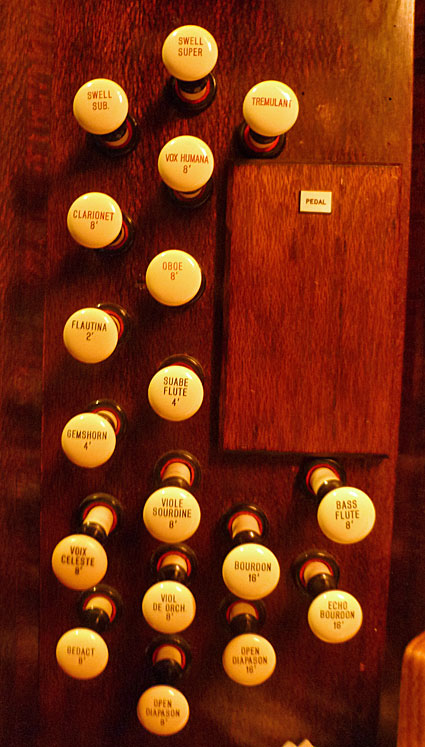
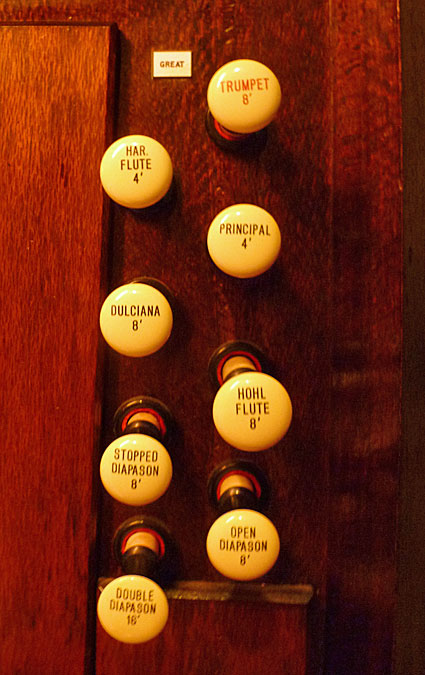
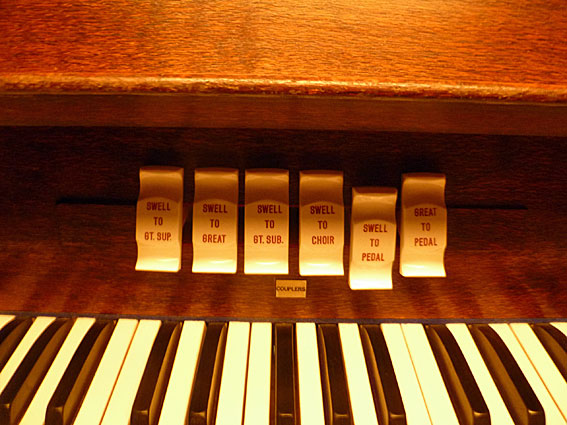
Console details
[Photographs by David Vann (November 2012)]
At the time of the rebuilding of the organ at St Andrew's Uniting Church, Creek Street, Brisbane in 1983-84, the Tuba 8ft stop (1922) was reportedly sold to the Southport School for incorporation into the organ,12 but it has never been added. The whereabouts of this stop are now unknown.13
The organ was overhauled, cleaned, re-wired and regulated in 1992 by W.J. Simon Pierce of Brisbane.14 The maintenance of the instrument was subsequently taken over by Ian D. Brown & Associates of Ballina, who lowered the wind pressures in 1997, undertook further repairs in 2000, and fully electrified the action to the facade pipes in 2003.15
Following damage caused by possums, cleaning and repair work was undertaken in the latter half of 2020 by Pierce Pipe Organs of Brisbane. Tuning slides were fitted the pipework to prevent further splits and damage.16
________________________________________________________________________
1 T. Max Hawkins, The Queensland Great Public Schools: A History (Brisbane: Jacaranda Press, 1965), pp. 159-61.
2 The Brisbane Courier (14 November 1921), p. 9; The Brisbane Courier (3 December 1921), p. 12; The Queenslander (10 December 1921), p. 40.
3 Personal communication to G. Cox from Robert Moore (Director of Music, The Southport School), September 1974.
4 The Whitehouse List gives "New 1924 £1,569.15.0". Whitehouse Bros Ledger (1922-1940), p. 115 shows that a deposit was paid in January 1924, but final payment may have extended to March 1925.
5 The Brisbane Courier (10 June 1924), p. 6; The Brisbane Courier (14 February 1925), p. 24.
6 The Brisbane Courier (14 February 1925), p. 17.
7 Richard Ward, 'Kings of the King of Instruments,' The Sydney Organ Journal, vol. 47, no. 2 (Autumn 2016), pp. 18-19.
8 Whitehouse Bros Ledger (1922-1940), p. 121 shows 'Nov 20th: supplying and fixing new 16ft Open Diapason,' and the date 1924 has been altered to 1925.
9 Specification supplied by Robert Moore, January 1973.
10 Organ Society of Queensland Newsletter, vol. 2, no. 8 (May 1976), and personal communication to G. Cox from David Vann, 1976. The details published in G. Cox, Gazetteer of Queensland Pipe Organs (Melbourne: Society of Organists, 1976), were based on proposals that did not eventuate.
11 Personal communication to G. Gox from David Vann, c.1979.
12 Personal communication to G. Cox from Steven Nisbet, 1989, confirmed by David Vann, 2003. The stop was reported by Robert Heatley around 1990 still to be in storage.
13 The Organ Voice, vol. 30, no. 2 (June 2003), p. 7.
14 The Organ Voice, vol. 19, no. 3 (December 1991), p. 55.
15 The Organ Voice, vol. 23, no. 4 (December 1997), p. 27; The Organ Voice, vol. 26, no. 3 (September 2000), p. 26; The Sydney Organ Journal, vol. 34, no. 4 (Spring 2003), p. 41.
16 "News from Organbuilders," OHTA News, vol. 45, no. 3 (September 2020), p. 4.